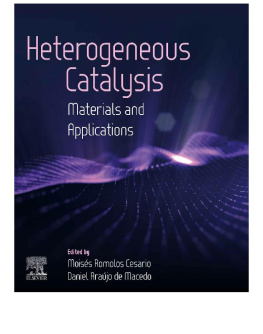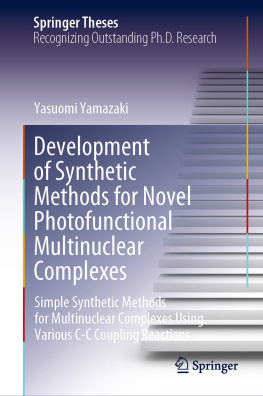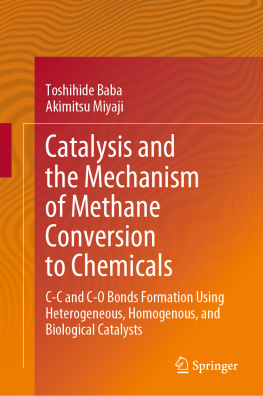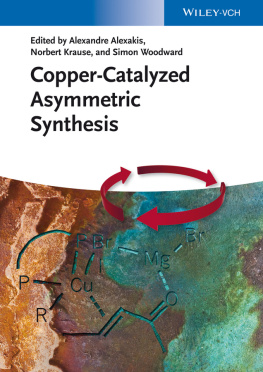Related Titles
Hoz, A. d. l., Loupy, A. (eds.)
Microwaves in Organic Synthesis
2012
ISBN: 978-3-527-33116-1
Andersson, P. G. (ed.)
Innovative Catalysis in Organic Synthesis
Oxidation, Hydrogenation, and C-X Bond Forming Reactions
2012
ISBN: 978-3-527-33097-3
Behr, Arno / Neubert, Peter
Applied Homogeneous Catalysis
2012
ISBN Softcover: 978-3-527-32633-4
ISBN Hardcover: 978-3-527-32641-9
Che, M. / Vedrine, J. C. (eds.)
Characterization of Solid Materials and Heterogeneous Catalysts
From Structure to Surface Reactivity
2012
ISBN: 978-3-527-32687-7
Yudin, A. K. (ed.)
Catalyzed Carbon-Heteroatom Bond Formation
2011
ISBN: 978-3-527-32428-6
Hall, D. G. (ed.)
Boronic Acids
2011
ISBN 978-3-527-32598-6
Steinborn, D.
Fundamentals of Organometallic Catalysis
2011
ISBN Softcover: 978-3-527-32717-1
ISBN Hardcover: 978-3-527-32716-4
Oestreich, M. (ed.)
The Mizoroki-Heck Reaction
2009
ISBN: 978-0-470-03394-4
All books published by Wiley-VCH are carefully produced. Nevertheless, authors, editors, and publisher do not warrant the information contained in these books, including this book, to be free of errors. Readers are advised to keep in mind that statements, data, illustrations, procedural details or other items may inadvertently be inaccurate.
Library of Congress Card No.: applied for
British Library Cataloguing-in-Publication Data
A catalogue record for this book is available from the British Library.
Bibliographic information published by the Deutsche Nationalbibliothek
The Deutsche Nationalbibliothek lists this publication in the Deutsche Nationalbibliografie; detailed bibliographic data are available on the Internet at < http://dnb.d-nb.de >.
2013 Wiley-VCH Verlag GmbH & Co. KGaA, Boschstr. 12, 69469 Weinheim, Germany
All rights reserved (including those of translation into other languages). No part of this book may be reproduced in any form by photoprinting, microfilm, or any other means nor transmitted or translated into a machine language without written permission from the publishers. Registered names, trademarks, etc. used in this book, even when not specifically marked as such, are not to be considered unprotected by law.
Print ISBN: 978-3-527-33254-0
ePDF ISBN: 978-3-527-64831-3
ePub ISBN: 978-3-527-64830-6
mobi ISBN: 978-3-527-64829-0
oBook ISBN: 978-3-527-64828-3
Cover Design Grafik-Design Schulz, Fugnheim
Typesetting Thomson Digital, Noida, India
Foreword
The field defined by the title of this monograph, Palladium-Catalyzed Coupling Reactions, has had a transformative effect upon organic synthesis, enabling bond constructions that could only have been dreamed about four decades ago. This has given rise to an immense and exponentially growing literature that encompasses far-reaching fundamental and applied topics. As of this writing, there is clearly no end in sight or approaching state of maturity.
The ongoing stream of developments can be ascribed to a number of factors, but one can begin with mechanism, where there are intricate subtleties regarding the homogeneous or heterogeneous nature of many transformations, as well as possibilities for cycles differing in the palladium redox states involved. Another driver would be applications, for example, the ability to effect new transformations or sequences of transformations, or render transformations that afford chiral products enantioselective or more highly enantioselective, or create catalysts with either improved functional group tolerance, or the ability to activate normally inert groups.
This line of thought leads into optimization issues. The desirability of longer lived catalysts capable of millions of turnovers is widely appreciated. One fundamental aspect of the quest for longer lived catalysts is to understand the processes by which they decompose or deactivate. When catalysts attain high turnover levels, recycling becomes especially attractive, and there are a plethora of strategies that can be applied, each with its own special strengths.
It is clearly a challenge to capture the essence of such a fast-moving field in a monograph. However, the Editor, Prof. rpd Molnr, is superbly credentialed. He has many original research articles dealing with catalyst development to his credit, as well as authoritative reviews on the subjects of recyclable palladium catalysts and sustainable Heck chemistry. He has furthermore assembled an outstanding team of authors with many leading luminaries of the field. It is clear from the end product that this group has been up to the task, going beyond a mere collection of reports and giving readers new ways of thinking about palladium-catalyzed cross-coupling.
The leadoff chapter by Khler, Wussow, and Wirth provides a textbook level introduction to various types of palladium-catalyzed cross-coupling reactions, representative types of molecular species that come into play, and equilibria involving monopalladium species, palladium cluster complexes, palladium nanoparticles, and bulk palladium. This is followed by Okumura's treatment of high-turnover zeolite-supported heterogeneous palladium catalysts, which illustrates the value of EXAFS and XANES techniques for catalyst characterization.
Recycling then becomes the focus in a chapter by Salih and Thiel, who describe the rapidly growing types of palladium catalysts that have been grafted to magnetic materials. The Editor, Molnr, then takes a turn, systematically reviewing the various classes of ordered porous solids that have been used as support materials for cross-coupling catalysts. Karimi, Abedi, and Zamani highlight a complementary theme, coupling reactions mediated by polymer-supported catalysts, in the following chapter.
The reaction medium then becomes the message. A chapter by Keler, Scholten, Galbrecht, and Prechtl describes cross-coupling reactions in ionic liquids. Shaughnessy then plumbs the depths of coupling reactions in water. In both cases, volatile organic solvents are avoided. Catalysts with appropriate phase labels are generally required, but these provide handles for recovery. In the following chapter, Wang and Wang detail the intricacies of microwave-assisted coupling processes, in which greatly reduced reaction times can be achieved.
In an essential chapter, Molnr begins by describing key general issues in catalyst recovery, and then vividly conveys the state of the art, concluding with tabular summaries of numerous recycling studies. Subsequently, Huang and Wong analyze the nature of the true catalytic species in recipes employing heterogeneous palladium precatalysts. Much evidence supports a role for soluble leached moieties. Process then becomes the focus. Reynolds and Frost review coupling reactions that have been carried out using continuous-flow systems. The volume concludes with a survey of industrial applications of cross-coupling reactions by Dumrath, Lbbe, and Beller.
In summary, this monograph informs, educates, and inspires. Both experienced practitioners and newcomers to this field will benefit from the insight and vision of a fantastic assembly of authors. Their superbly interwoven chapters are poised to influence every reader's future, and foster the next generation of seminal developments in palladium-catalyzed cross-coupling reactions.
College Station, Texas
John A. Gladysz
Next page






